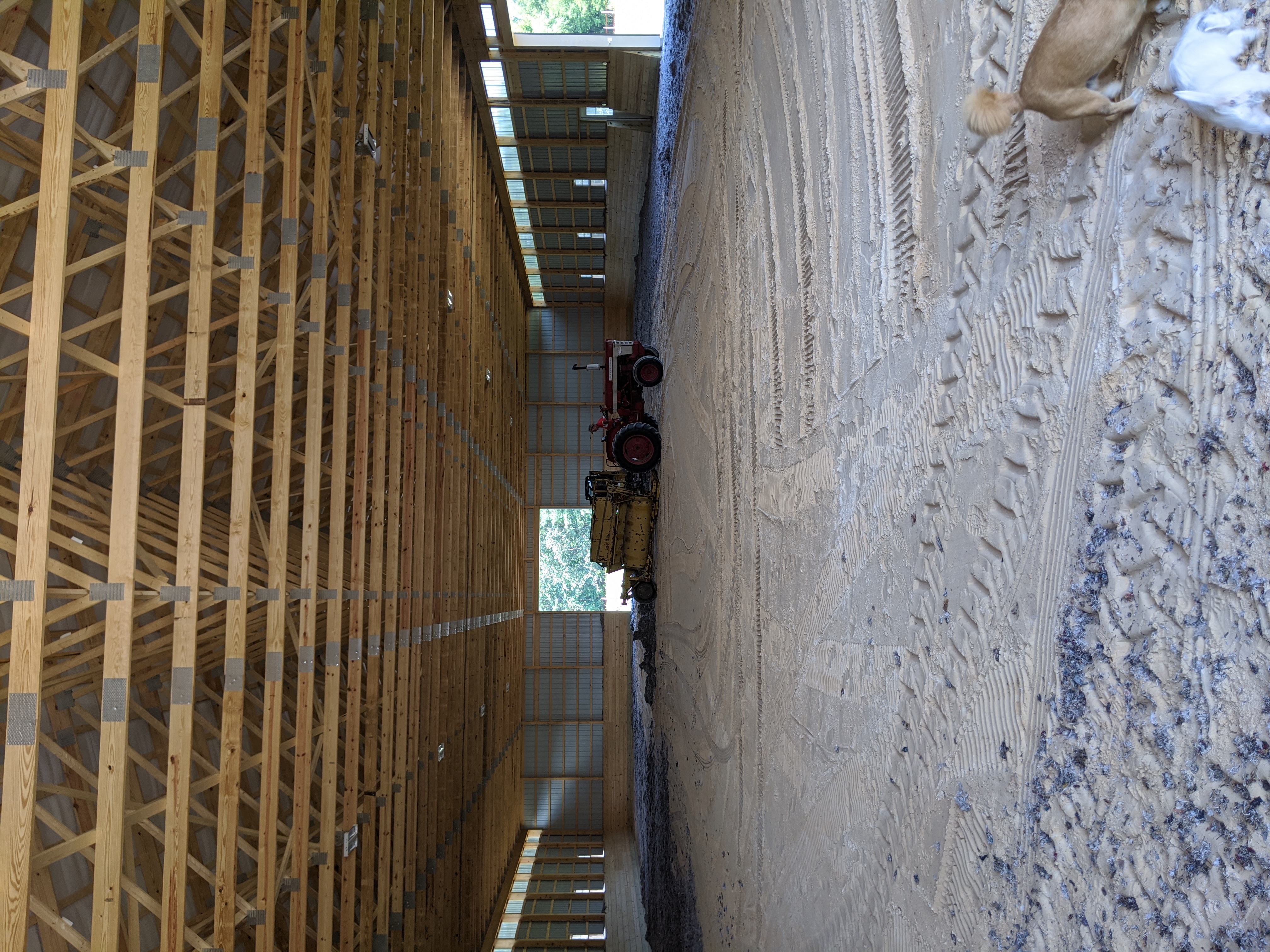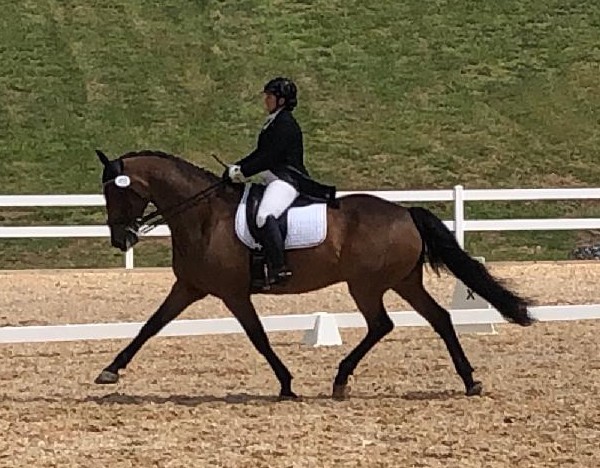Does anyone else feel like summer is, in dressage terms, running forward?
I was going to add a dressage joke here about a half halt, but that’s too predictable.
In my last blog, I talked about the framing of the inside of the barn and stalls and the base of the indoor and the footing being delivered. Since then, we have made more progress and then some things have been put on hold, as often happens in construction.
Dave Wisner of K and L Contracting finished installing the base in the arena and then waited about a week to come back and install the sand and fiber. In that time, we were making sure the base was watered so that it was firm and locked into place and also to make sure that the stone dust base did not pull moisture from the sand. I’m not sure I really understood this, but we did what Dave asked since he’s the expert! So several evenings were spent in the indoor with hose—and possibly a drink—in hand, wetting it down. It was actually a nice job, as it’s been pretty hot here. We also used sprinklers to help, which my daughter Lu thought was very fun as she got to play in them.

As an Amazon Associate, Dressage Today may earn an affiliate commission when you buy through links on our site. Products links are selected by Dressage Today editors.

Dave also took this time to install grids to keep mud down in high traffic areas. I will include a picture of one of the grids. They are packed with stone dust to prevent divets and mud. We are eager to see how they work, if we like them, we plan on adding more around the farm.

DT Editor’s Note: Like these mud grids? See similar ones here.
Inside the barn, the concrete was poured for the aisle way and the Byler Builders guys installed the ceiling in the aisle. I opted to have the ceiling only over the aisle so that the space above the stalls was still open for ventilation and air flow.
The week that Dave gave us to let the base really get a good soaking gave us the perfect opportunity to have the electrician come in to begin wiring for the lights and outlets throughout the indoor and barn. We needed quite a few outlets as each stall will have a fan and each stall has its own light. We wanted to make sure that we didn’t put the footing down until there weren’t any more vehicles that needed to drive in the indoor. We will have high-intensity LED lights throughout the barn and indoor.


Once the lights were installed in the indoor, Dave came back to spread the sand. Again he used laser leveling to make sure that the sand was 1.5 inches throughout. I was able to stop by to see the sand and Dave walked around with me with a tape measure and showed me how even it was in several different places. I was definitely impressed. We had thought about trying to do this step ourselves and I am sure glad we didn’t. I think having even and consistent footing is so important and I don’t think we could have achieved this on our own.
Once the sand was installed, we watered again to make sure the sand was nice and moist so that when he mixed the fiber, it would bind together. So we spent a few more evenings of watering—again, possibly with a drink. I think the dogs and Lu had more fun with this than we did!
After a few days, Dave returned to install the fiber. Dave warned us that this is kind of a messy job because he uses a machine that shoots the fiber out to where he wants it and in doing so, some gets on the kickwalls, etc. It tends to come out in some clumps, so Dave then works the fiber in so that it is mixed with the sand. This part is very important. If this step is skipped, the fiber will sit on top of the sand and the fiber will be pulled out when the arena is dragged.
Once the concrete was poured in the barn, we went into a waiting game for the stall fronts. Jeff Byler has been in constant contact with us saying that they are busy making them and we just have to wait. Although this is hard and we are more than ready to move in, I can’t really complain as the stall fronts are being custom made and if they are at all like the outer stall doors, I am sure they are going to be worth the wait!
As we wait for the barn to be finished, there is still much to do. The fencing guy got started on the paddocks. I am having an individual paddock for each horse. I chose high-tensile coated wire. I did a lot of research on this and talked to many people and friends about this fencing. Everyone who has it loves it and it’s very safe for the horses. Some of the paddocks will be connected so the top and third row of wire will be electrified. I chose this configuration of turn out because I believe it’s the most like a herd environment but still allows the safety of individual turn out. There will be gates connecting each paddock so that I can open them up to make bigger spaces if needed. This is a big job with a lot of details with how we configured the paddocks. We met with several different fencing companies to get quotes and to ask questions about how they install their fencing.


We chose Natural Concepts Landscaping and Fencing owned by Steve Windsor. Steve has been wonderful to work with. Even when we asked for some changes, he didn’t bat an eye and said he would get whatever we wanted. He has an attention to detail that we very much appreciate. I was pretty specific about the gates that I wanted (no-climb gates) and they were difficult to find due to a shortage of materials because of COVID-19, but he found them and drove to Pennsylvania to make sure that’s what we got. What we also like is that he stands behind his product and assured us that if we have a problem with the fencing in the future, he will be here to fix it. He does pond management as well and this is great becuse we will need some management for the bioretention ponds.
Speaking of the bioretention ponds, those should be starting soon. Hopefully I will be able to update you all on that in the next blog.
We were hoping to be moved in by July 1. Obviously that didn’t happen, but we are being patient as we want everything to be just right!
In the middle of all of this, I took six horses and students to Dressage at Lexington last weekend in Lexington, Virginia. I was feeling a bit overwhelmed but, hey, I like to think I do well under pressure! I got into the FEI ring again for the first time in something like 20 years. I know, I know. Crazy, right?! I rode my student, Ashley Ockels’ wonderful horse, Renoir, in the Prix St. Georges. I have never shown him before as he’s a fairly new horse in the barn, so why not jump right in at Prix St. Georges? Friday’s test had a lot of mistakes as I had nerves and overrode. We got a 60 percent even with several very costly mistakes. I learned a lot about how to ride him in the ring and Saturday’s test was much better. I made a few changes and didn’t override and I let him do his thing. I think he was saying “Hey lady, let me do my job!” We had a clean test and ended up in third place in a large and very competitive class with a 67 percent! I may or may not have shed a tear or two as we left the ring!

I hope everyone has great rides until we talk again!
Stay tuned for stall fronts! We all know I’ve been waiting to see them!

Click here to read more of Kelly’s blogs about building her dream farm!
DT Editor’s Note: Want to read more about building your own dressage facility? Check out the following books that have been selected by the DT Team:
Horsekeeping on a Small Acreage: Designing and Managing Your Equine Facilities by Cherry Hill
Horse Housing: How to Plan, Build, and Remodel Barns and Sheds by Richard Klimesh
Ultimate Horse Barns by Randy Leffingwell
Complete Plans for Building Horse Barns Big and Small by Nancy W. Ambrosiano
Kelly McGinn is an FEI rider, trainer and coach. She has brought many horses and riders up through the levels and has enjoyed success in regional and national championships as well as year end awards. Kelly was also chosen to ride the Friesian stallion Lolke 372 in the opening ceremonies of the World Equestrian Games in 2010 in the famed 10 horse Friesian train. Kelly has trained with Scott Hassler since 1991 and she credits Scott for her teaching and training style as he has been a big influence in her education. Kelly has also had the opportunity to ride with many well known clinicians including Steffen Peters, Michael Klimke and Debbie McDonald. Kelly also participated in the Young Dressage Trainers Symposium for 9 years where she developed a love for the process of training young horses. She runs a small teaching and training business in Easton, Maryland, where she has a variety of different horses in training and believes that every horse can benefit from good dressage training regardless of the breed.











